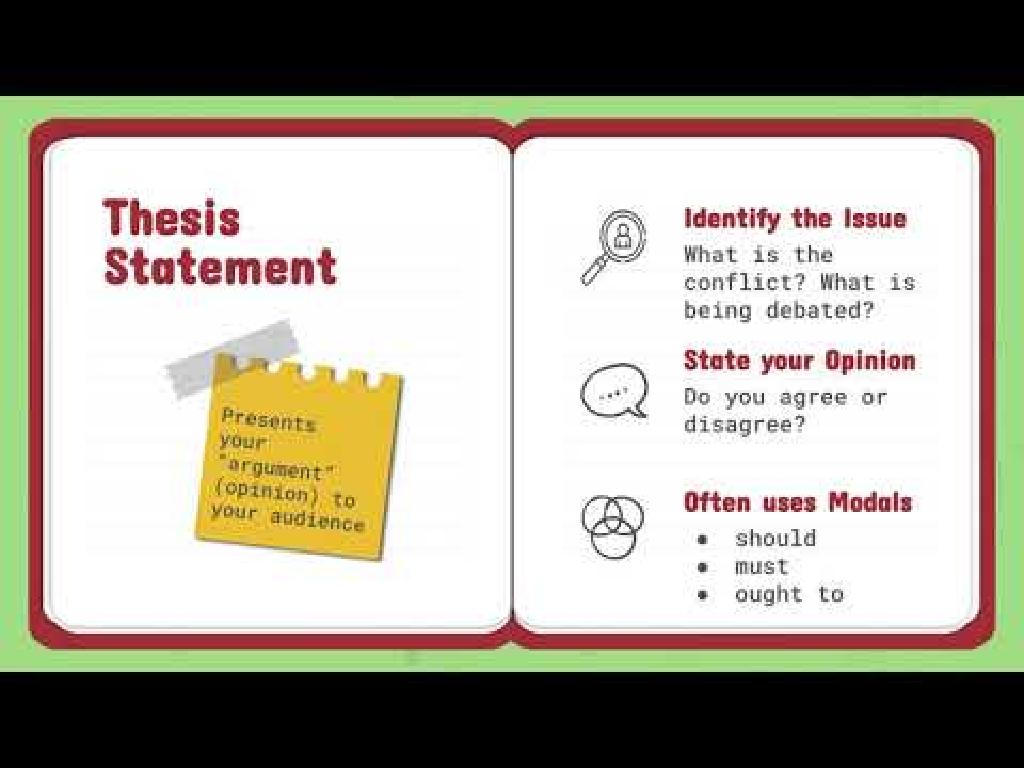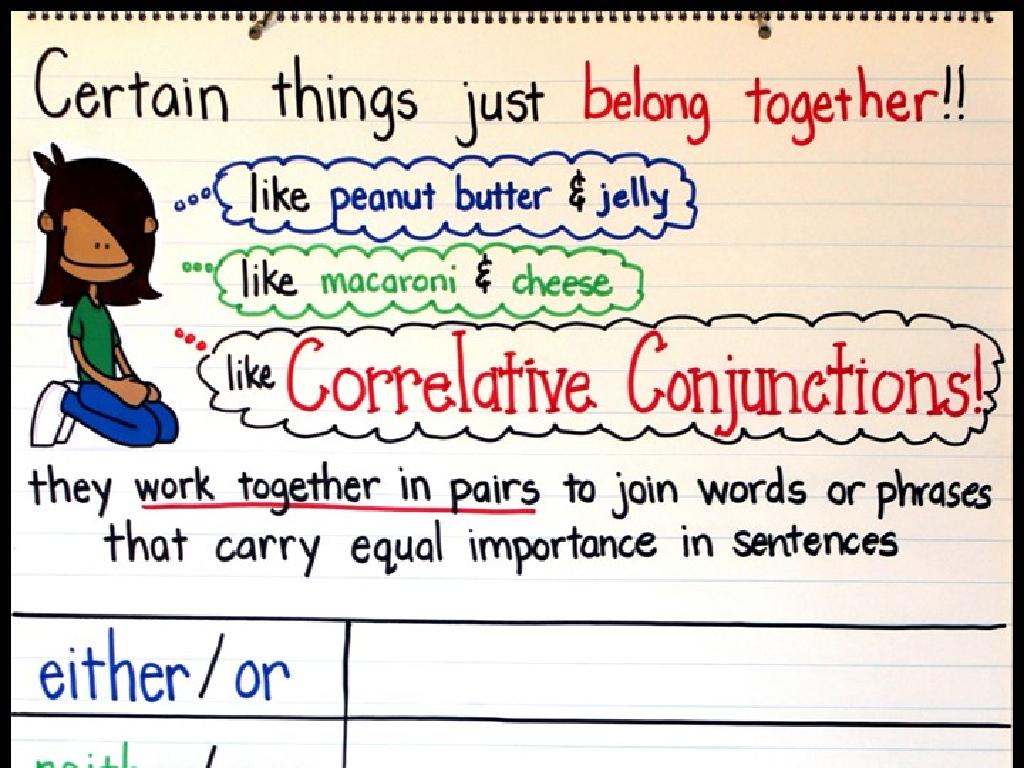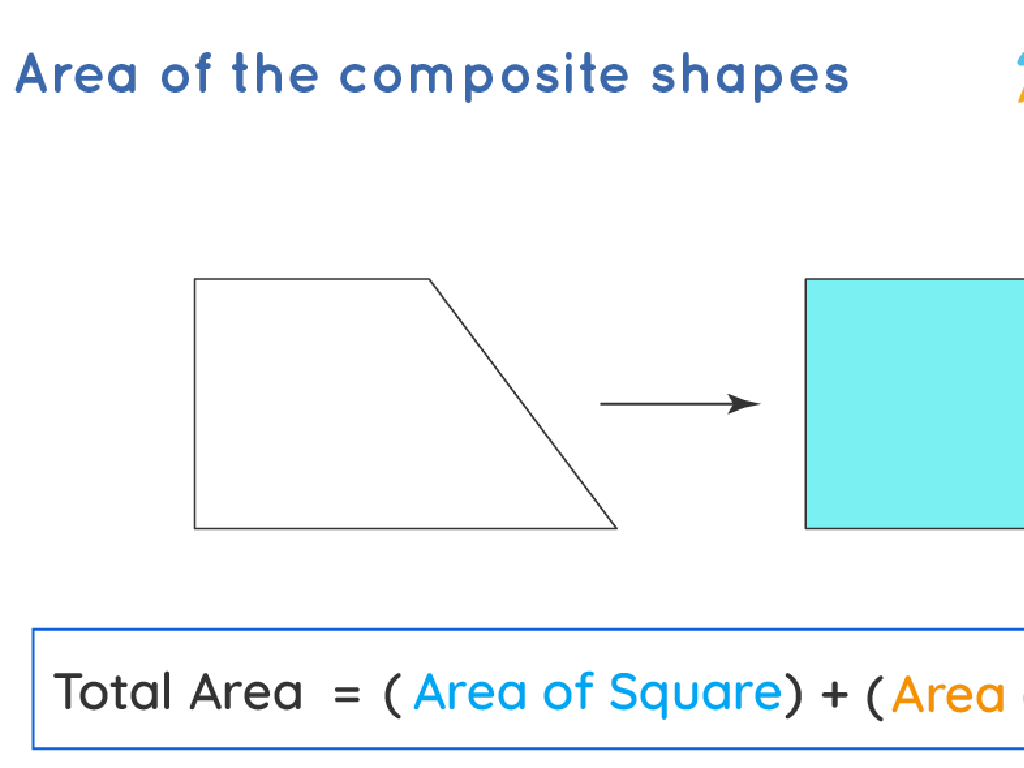Take Apart Numbers Up To 5 - Addition Sentences
Subject: Math
Grade: Kindergarten
Topic: Take Apart Numbers Up To 5
Please LOG IN to download the presentation. Access is available to registered users only.
View More Content
Math Fun: Taking Apart Numbers Up to 5
– Play with numbers up to 5
– Learn to take numbers apart
– Break down numbers into smaller pieces
– See how numbers combine
– Numbers can join to make bigger ones
– Practice with addition sentences
– Use ‘+’ sign to add numbers together
|
This slide introduces the concept of deconstructing numbers up to 5, which is a foundational math skill for Kindergarten students. The objective is to help students understand that numbers can be broken down into smaller parts and recombined to form the same number. For example, the number 5 can be taken apart into 2 and 3. Activities can include using physical objects like blocks or counters to visually demonstrate the concept. Encourage students to explore different ways to break apart each number up to 5 and then use addition sentences to put them back together. This will also reinforce the concept of addition as putting together and increase their number sense.
Taking Apart Numbers Up to 5
– Understanding taking apart numbers
– It means dividing numbers into smaller groups.
– Breaking numbers like sharing cookies
– Imagine splitting a cookie to share with friends.
– Practice with numbers 1 to 5
– Let’s try with numbers: 2 is 1+1, 3 is 1+2 or 2+1.
– Addition sentences from parts
– If we have 2 and 3, we can make 5 by adding 2+3.
|
This slide introduces the concept of decomposing numbers, which is a foundational skill in understanding addition and subtraction. Use tangible examples like breaking a cookie into parts to make the concept relatable for kindergarteners. Encourage hands-on activities such as using physical objects to represent numbers and breaking them into smaller groups. This will help them visualize the concept of taking apart numbers. The goal is for students to recognize that numbers up to 5 can be split into different combinations of smaller numbers, and these combinations can be represented through addition sentences.
Exploring the Number 2
– Understanding the number 2
– Number 2 is made up of two 1s
– Combining 1 and 1 makes 2
– 1 plus 1 equals 2
– Taking apart 2 into 1 and 1
– 2 minus 1 leaves us with 1
|
This slide introduces the concept of addition and subtraction using the number 2 as a foundation. Start by explaining that the number 2 can be created by adding two 1s together. Use visual aids like blocks or fingers to show one item plus one more item equals two items. Then, demonstrate that if we start with 2 items and take 1 away, we are left with 1 item. This concrete representation helps Kindergarten students grasp the basic principles of combining and separating numbers. Encourage the students to practice with real objects to solidify their understanding. For the activity, have students pair up and use manipulatives to combine and separate groups of 2 items, fostering a hands-on learning experience.
Exploring Number 3 with Addition
– Understanding the number 3
– Combining numbers to make 3
– 1+1+1=3 or 1+2=3 shows making 3
– Taking apart 3 into smaller numbers
– 3 can be split into 1, 1, and 1 or 2 and 1
– Addition sentences for number 3
– Examples: 3=1+2 and 3=1+1+1
|
This slide is focused on helping Kindergarten students understand the concept of the number 3 through addition sentences. Start by explaining that numbers can be made by combining smaller numbers. Show them how the number 3 can be created by adding 1+1+1 or by adding 2+1. Then, demonstrate that the number 3 can be taken apart into 1, 1, and 1 or into 2 and 1. Use visual aids like counters or blocks to help students visualize the concept. Encourage them to come up with their own ways to make and take apart the number 3. This hands-on activity will solidify their understanding of addition and the composition of numbers.
Exploring Number 4: Addition Sentences
– Ways to make number 4
– 1+1+1+1 or 2+2 equals 4
– Combining ones to make four
– Add 1 four times: 1+1+1+1
– Making four with two pairs
– Two plus two also makes 4
– Taking apart number 4
– Break 4 into 1+1+1+1 or 2+2
|
This slide is aimed at helping Kindergarten students understand that the number 4 can be made and taken apart in different ways using addition sentences. Start by showing them that adding four ones together makes four. Then, demonstrate that combining two pairs of twos also results in the number four. Encourage the students to visualize this by using objects like blocks or counters to group and separate into ones and twos. This hands-on activity will help solidify their understanding of basic addition and the concept of decomposing numbers.
Exploring Number 5
– Making 5 with ones
– 1 + 1 + 1 + 1 + 1 equals 5
– Making 5 with twos and one
– 2 + 2 + 1 also makes 5
– Taking apart 5 into ones
– 5 can be split into 1 + 1 + 1 + 1 + 1
– Taking apart 5 into twos and one
– 5 can be split into 2 + 2 + 1
|
This slide is focused on helping Kindergarten students understand that the number 5 can be composed and decomposed in different ways using addition sentences. Start by showing them how to make 5 by adding five ones together. Then, demonstrate that 5 can also be made by adding two twos and one. Similarly, explain that the number 5 can be broken down into five ones or into two twos and one. Use visual aids like counters or blocks to help students visualize the concept. Encourage them to try making 5 using different combinations of numbers up to 5. This hands-on activity will reinforce their understanding of addition and the concept of taking apart numbers.
Addition Sentences: Combining Numbers
– Addition sentences combine numbers
– Example: 1 + 1 = 2 makes 2
– It’s like adding 1 more apple to 1 apple
– Write sentences for 2, 3, 4, 5
– 2 can be 1 + 1, 3 can be 1 + 2, and so on
– Understand how numbers add up
– See how different numbers join to make a new number
|
This slide introduces the concept of addition sentences to Kindergarten students, showing them how individual numbers can be combined to create new numbers. Start with the simplest example, 1 + 1 = 2, and use tangible items like blocks or apples to visually demonstrate the concept. Then, guide the students to write their own addition sentences for the numbers 2, 3, 4, and 5. Encourage them to think of different combinations that add up to these numbers, reinforcing the idea that numbers can be taken apart and put back together in various ways. This activity will help build a foundational understanding of addition.
Class Activity: Number Puzzles
– Time to explore numbers!
– Use puzzles to take apart numbers
– Break apart numbers and put them back together like a puzzle
– Find ways to make numbers up to 5
– Discover all combinations to create numbers 1, 2, 3, 4, and 5
– Collaborate with classmates
|
This interactive class activity is designed to help Kindergarten students understand the concept of decomposing numbers up to 5. Provide students with puzzles that visually represent numbers being broken apart and reassembled. Encourage them to work in small groups to foster teamwork and discussion. As they explore, they should find all possible combinations for each number, such as 2+3 for 5 or 1+1 for 2. This hands-on approach aids in developing their addition skills and understanding of number composition. Possible activities include using blocks, drawing representations, or using fingers to count. Monitor the groups to ensure all students are engaged and understanding the concept.






